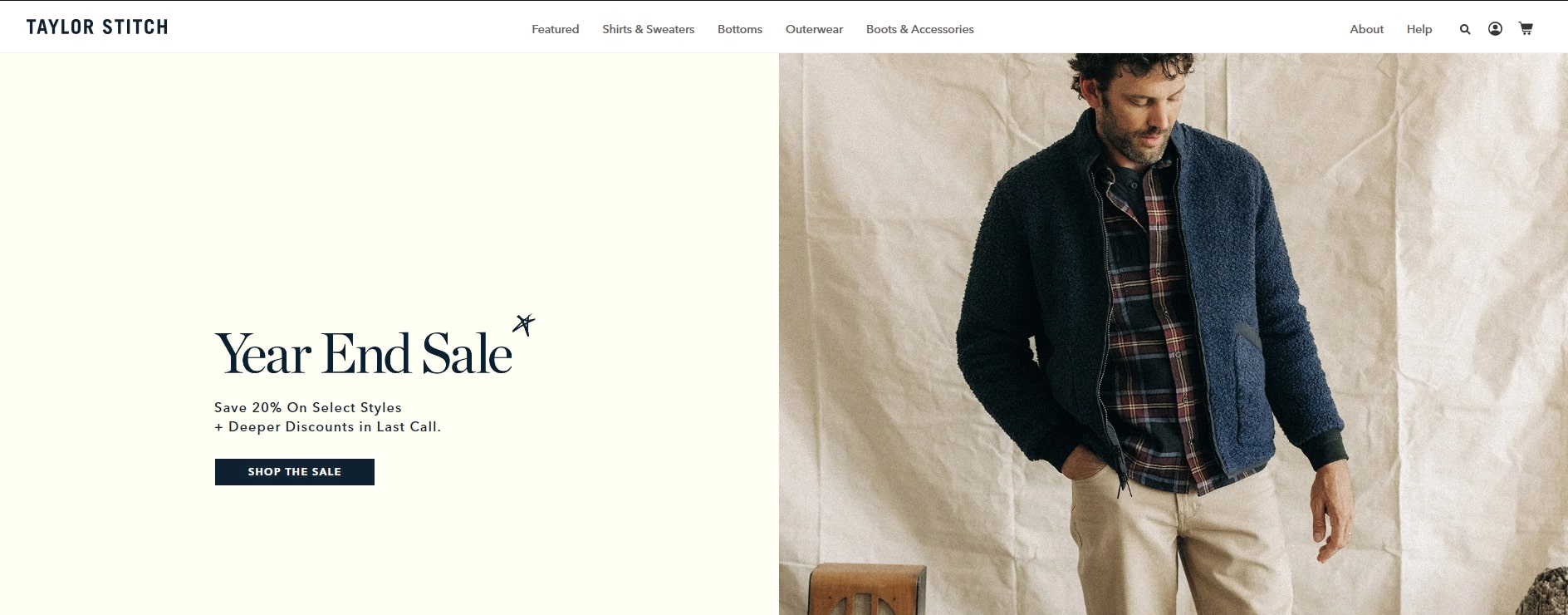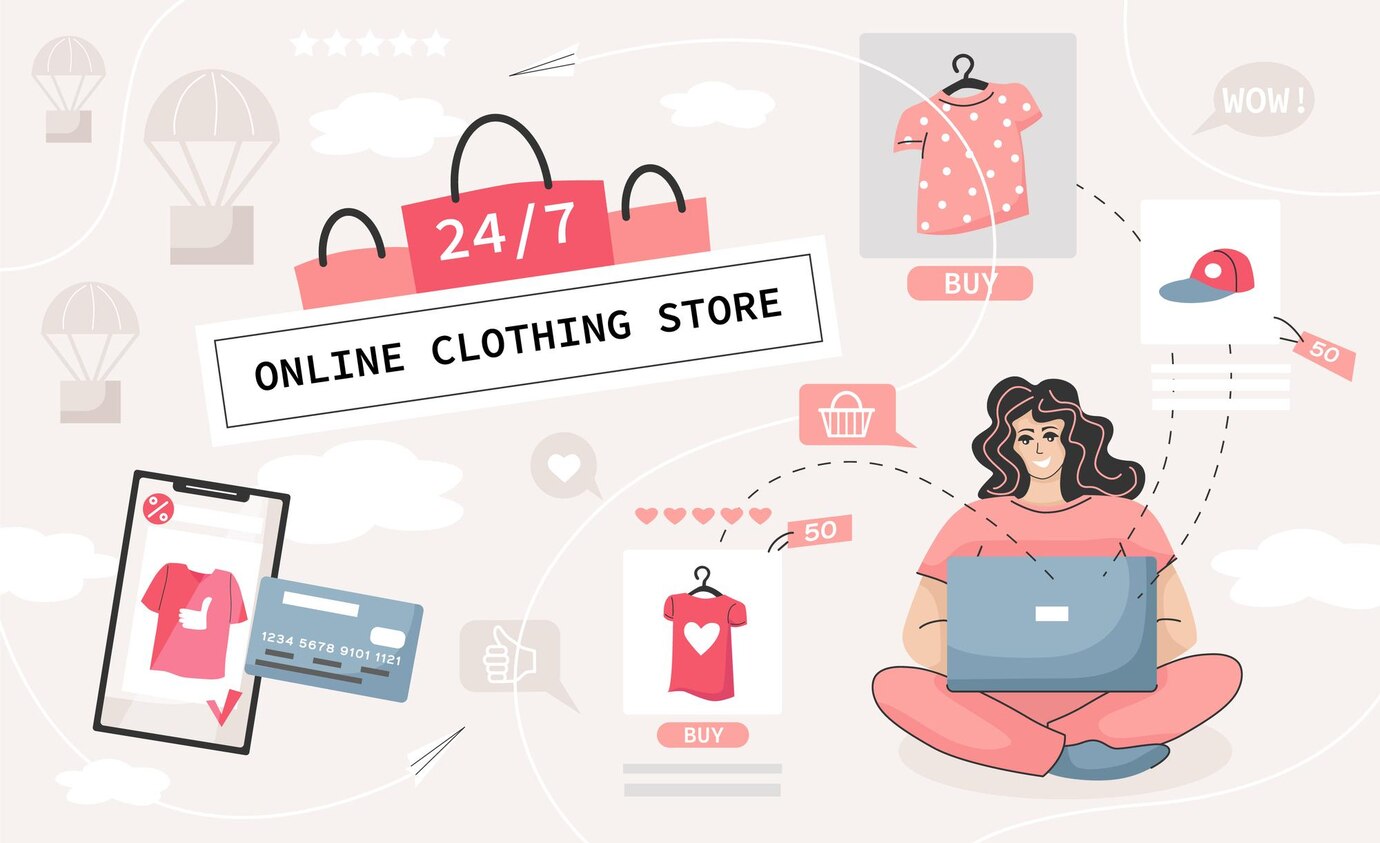If you’ve ever dreamt of turning your passion for fashion into a thriving business, this blog post is your roadmap to success. Today, we’ll explore the essential steps and valuable insights on how to start an online clothing store. Let’s transform your fashion aspirations into a digital retail reality!
Contents
- 1 Why Should You Start An Online Clothing Store?
- 2 How To Start An Online Clothing Store With No Money: A Detailed Blueprint
- 3 Successful Online Clothing Businesses
- 4 Wrap-Up
Why Should You Start An Online Clothing Store?
The Rise of Online Boutiques
The Internet explosion and the COVID-19 pandemic have paved the way for eCommerce evolvement. Of course, the fashion industry is not out of this trend. In the year 2023, revenue generated from the online sale of fashion apparel, footwear, and accessories in the U.S. is anticipated to surpass 207 billion U.S. dollars. By 2027, the online fashion retail sector could witness substantial growth, potentially contributing to over 300 billion dollars in sales.
If you do not want to miss this precious chance, do not hesitate to launch your very own online clothing store.
Opening an Online Clothing Store – Opportunities and Challenges
When it comes to selling online, a low entry barrier will be the first advantage most people think of. While it takes only a few days or weeks to launch an online store, the process can last much longer for a brick-and-mortar outlet.
Besides, when operating traditional stores, the expenses for hiring staff can be considerable. But, these employees can keep the shops open for only a limited time. eCommerce stores are, on the other hand, accessible to anyone 24/7.
Now, let’s talk about challenges. As clothes are special merchandise, consumers prioritize physical exposure. It is not until customers touch the fabric and try clothes on that they are confident in their choices. That’s why the majority of apparel sales still take place in offline stores.
How To Start An Online Clothing Store With No Money: A Detailed Blueprint
In this section, we’ll discover the best way to start an online clothing store by following these 8 essential steps, guiding you through a seamless journey to launch and establish your successful e-commerce venture.
Step 1: Decide Your Clothing Niche

Deciding clothing niche is vital to the success of an online clothing store business plan, both online and offline. When it comes to clothes, consumers have different needs. Instead of appealing to everyone, focusing on specific target customers will be a better idea. Bear them in mind so that the goods you offer will pique their interest.
For instance, should you sell male athletic shirts and pants, it is great to provide accessories like jackets and shoes. On the other hand, expanding to women’s swimsuits can be counterproductive.
Another necessary factor to take into account is customer lifetime value. While acquiring new clients demands enormous effort, selling goods to existing ones is much simpler. Thus, you should offer commodities that keep your customers repurchasing to boost profits.
If you still wonder about choosing a clothing niche when opening an online clothing store, don’t miss these 3 tips:
- Uniqueness is the key
- Choose a niche in which you are interested and have a good understanding
- Ensure the earning potential of your niche
Step 2: Determine Your Business Model
Once you have done with the clothing niche, it is a perfect time to look for a model that is compatible with your business objective. Here are the four most popular business models of online clothing stores you can adopt:
- Print-on-demand
- Custom-cut-and-sew
- Private label
- Dropshipping
To know more about the pros and cons of these models, take a look at the information below.
Print-On-Demand
If you want to start an online clothing store with a limited budget, the Print-On-Demand model is the best option. According to GlobeNewswire, the revenue from custom T-shirt printing is measured up to $10 billion in 2025.
For this model, you add the logo and design onto blank apparel based on customer orders. All the process is automated and does not require a high level of technical skills. So, your business can save money by reducing labor.
However, print-on-demand stores normally generate lower profits, especially for third-party printers. Besides, choices seem limited in terms of branding tags and other finishes.
Discover now: 9+ Best Shopify Print-on-Demand Apps Free & Premium 2024
Custom-Cut-And-Sew
Do you desire to have your very own fashion business? Do you have a generous budget? There is nothing more optimal than the Custom cut-and-sew model for anyone fulfilling these criteria.
As the name implies, you are in charge of everything, from creating designs to manufacturing. In addition, you are liable for finding fabric suppliers and managing pattern making process. Thus, along with the large budget, you need to devote a huge amount of time. And, of course, a deep understanding of design principles is required when implementing this model.
In return, you can come out with truly unique clothes. By customization, you can also bring “personalization” to your customers.
Private Label
For store owners who want to create an online clothing store on Shopify without putting too much effort, the Private Label model will not fail to satisfy them.
In essence, you buy clothing items either blank or with no label, then put your custom label/ design on. Consequently, these commodities come on the market under the name of your brand.
Due to bulk buying, you receive a more reasonable rate compared to the print-on-demand model. That is why not only does this model offer more clothing customization but it is also more cost-effective than the first model.
On the contrary, you are still in charge of inventory management as well as fulfillment. Fortunately, some platforms such as Threadbird enable you to buy and custom-finish clothing, thus simplifying the tasks.
Dropshipping
If you wonder how to start an online clothing store without inventory, the dropshipping business model is the best choice for you. So how does dropshipping work? Where there is an order for a specific item, the drop shipper transfers it to a third-party business for direct delivery to the client.
The most overwhelming advantage of dropshipping is that there is no demand for inventory on hand. Also, you need not worry about packing or shipping merchandise. To set up a dropshipping enterprise, we suggest integrating some Shopify dropshipping apps into the online store.
Nevertheless, the competition in dropshipping proves to be fierce. The goods are not as unique and can be bought from hundreds of suppliers. Therefore, making your online store stand out will be a tough challenge.
A helpful guide: How to become a dropshipping supplier
Step 3: Choose your Domain Name

The next step is giving your business a name, more specifically a domain name. Having a unique domain name will create a professional look for your store and make a good impression on potential customers. The domain name should be compatible with the business name and available commodities.
There is no specific formula for choosing the name. But, here are some golden rules that you should remember
- Keep the domain name short and easy-to-spell: Hard-to-spell names can be a hindrance when customers look for your site or share it with others. Taking advantage of basic words and phrases will help you avoid this unexpected problem.
- Select a scalable domain name: The state of the business will vary from time to time. Therefore, it is worth thinking about potential growth when naming your online store.
- Be unique: No one wants their brands to be mistaken for competitors. Creating a unique name is a good way to differentiate your online store in the crowded eCommerce space.
Hope it help:
Step 4: Select your eCommerce platform
Once you have identified your target customers and business strategy, you can start looking for a storefront. In addition to streamlining the process of designing an online store, online store builders can assist business owners in solving backend matters such as security upgrades or SSL certificates. Moreover, this software solution is responsible for encrypting communications between customer internet browsers and your eCommerce website, thus securing the transactions.
There are thousands of eCommerce platforms out there. To help you make a better choice, consider the following factors:
- Business model
- Technical skills
- The features you require (eg: SEO, SSL Certificate, email marketing)
To narrow it down, Shopify, WooCommerce, BigCommerce, Magento, and Wix are the top 5 most popular eCommerce platforms you should learn about. There is no one-size-fits-all option. But, based on overall performance, we will strongly recommend Shopify due to four main reasons:
- High storage capacity: Shopify adopts cloud storage. So you don’t need to be concerned about servers or databases. Business operations will become more centralized and easier.
- Professional interface: Users can get access to diverse interfaces for many different industries such as F&B, furniture, jewelry, and clothing.
- Speed and security: Page loading speed optimization is the first factor to keep customers on the website. Besides, Shopify offers the best service in terms of security and avoiding data loss.
- Advanced features: You can completely customize the website easily, and integrate features such as advertising, and payment methods,…
>>> Read more: Shopify Pricing Plans: Which Is The Right Choice For Your Store
Step 5: Choose A Template And Theme

The next step to start an online clothing store is deciding on a store theme. Choosing a business name will be an exciting part when brainstorming with a group of colleagues. However, for those launching eCommerce stores on their own, the fifth step can bring a lot of fun.
Easy-to-use and easy-to-navigate (even for non-tech savvy) are two main criteria of a qualified eCommerce site.
Should you be a Shopify store owner, spend time browsing through 100+ Best Shopify Themes. If you find yourself overwhelmed by numerous options, consider the Eurus theme as one of the finest choices. Choosing a store theme is, to some extent, similar to choosing your outfit. So, we advise giving a few templates a try before deciding on the final one. You should also spend time making adjustments to make the final template as friendly to search engines and customers as possible.
Related topics:
Step 6: List Your Products
No matter what eCommerce platform or template you are utilizing, you need to guarantee that clothing items are displayed in an eye-catching manner along with all the necessary information. Fortunately, choosing an appropriate template is half the battle.
Now, let’s dive deeper into four specific tasks in this step:
- Product description: Product description plays an integral role in informing customers of what you offer and persuading them to purchase from you. To create high-quality content, think of the details you seek when shopping online and use them as a guideline. As product descriptions pose a significant impact on SEO ranking, you’d better take the most advantage of keywords.
- Product image: Since consumers can not physically touch your merchandise, the product image will be an effective tool to conquer them. Clothes need photographing of models or at least a mannequin. Buyers also expect to see the fabric and side details so do not forget to encompass these features in photos.
- Checkout: According to research by Baymard Institute, 18% of customers abandon sales due to the complicated checkout process. So, making this phase easier supports your store in transforming potential clients into true buyers. Normally, the checkout page comprises payment options and returns with promotion information.
Related topics:
Step 7: Launch Your Store

Before going public, make sure you check the website to detect any errors. If you are concerned that you might overlook some crucial things, you can enlist the assistance of other people with page previewing. When you feel sure about the website function, we suggest bringing it closer to buyers via three basic marketing tools:
- Email marketing: Encourage your clients to sign up for regular newsletters. In this way, you can cultivate customer relationships and increase their chances of being loyal customers. At the same time, don’t forget to include the “unsubscribe” option. If clients no longer show interest in your clothes, the option will be a solution.
- Social media marketing: According to a Digital report by Hootsuite, 27% of Internet browsers get access to new products via social media advertising. Thus, social media is a “must-have” marketing channel for any enterprise. You can start with sponsored posts to increase fan page followers. Then, employ knowledge-sharing and contests to build engagement.
- Content Marketing: According to Hubspot, nearly 50% of customers refer to Google as their first choice when discovering new merchandise. Effective content can ensure a higher rank in the search list. Here are three pieces of advice to publish strong content: be original, focus on keywords/phrases, and use diverse content formats (videos, podcasts, blogs, and so on).
Related solutions:
Step 8: Revise, Reinvent, and Renew
Congratulations! You have now reached the final phase of completing the steps on how to set up an online clothing store. All you need to do in this step is apply the 3R – Revise, Reinvent, and Renew. By analyzing data, you can revise your business performance thoroughly. When you have figured out what functions well and what does not, you can reinvent and renew by following the below tips:
- Promote your best-selling commodities on the homepage
- Fulfill underperforming pages with new product copy
- Include a rating system and customer testimonials for all products.
📌📌📌 Top-rated Apps to improve your store performance and conversion by BSS Commerce
Successful Online Clothing Businesses
To prove it is not impossible to start an online clothing store, we will accompany you on our journey to discover the some most successful online fashion business case studies.
#1 Alo Yoga

As can be inferred from the name, Alo Yoga offers both men’s and women’s yoga clothing as well as accessories. The site is built on the Shopify platform with a simple layout. While the Alo Yoga site displays a variety of products, it still ensures easy navigation for visitors.
So, what makes the Alo Yoga site stand out? The answer lies in its “Alo Moves” and “Alo Gives” sections. By subscribing to a $20/month program, you can take yoga and meditation online courses in Alo Moves. On the other side, Alo Gives collaborates with Scholastic to provide kids with 100% free yoga videos and activity sheets. With these programs, Alo Yoga gradually expands yoga to potential customers, thus increasing their sales while creating wellness benefits for society.
#2 Taylor Stich

Another popular fashion brand on Shopify is Taylor Stich. Taylor Stich knows how to create a great impression on customers from the beginning with a special popup. This popup enables site viewers to connect through the Facebook pages. Therefore, customers do not need to type a letter.
The next thing catching our eyes is stunning outdoor landscape photography. There is also a “Workshop” page on the site where new merchandise is crowdfunded. As a result, customers can save 20%. Furthermore, seasonal items will be made to order, which is a more sustainable practice.
Look and learn: Top 11 Inspiring Shopify Clothing Stores Examples To Follow & Learn
Wrap-Up
Finally, we have completed 8 steps on how to start an online clothing store. BSS Commerce Shopify hopes that the above tips and advice can make your online startup dream come true more easily. As there is still a long way to go, BSS Commerce Shopify is always willing to support you in this journey as an eCommerce solution partner.
Click here to learn more about us and our Shopify store development services.







